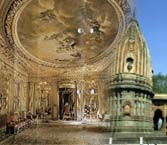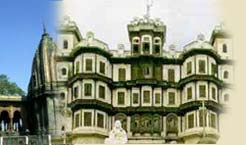|
Indore is the commercial capital of the state of Madhya Pradesh in central India. The city has historic significance and is one of the major industrial cities in the state. The city is also important for educations in the state, as many noteworthy institutions, including the Indian Institute of Management are situated in it. The city has many important tourist spots and is an important part of tourism in Madhya Pradesh. Touristplacesinindia is a travel guide that provides all the relevant information about Indore, in addition to information about the other tourist places in India.
Fast Facts

| Area | 165.17 sq. km
| Population | 1597441
| Altitude | 567 meters
| Languages | Hindi, Marathi and English
| Best Time to Visit | October-March
| STD Code | 0731
| | | | | |
History
The region was originally ruled by the local landlords who received titles from the Mughul rulers. The baton was eventually passed onto the Peshwas , the Maratha rulers after Shivaji. The Peshwas transferred Indore to the rule of the Holkers in 1733, when the then Peshwa awarded Malhar Rao Holkar the Indore region as recognition of his courage and loyalty. Malhar Rao is the founder of the Holkar dynasty. He was succeeded by his daughter-in-law, Rani Ahilya Bai Holkar, who ruled from a fortified palace at Maheshwar on the northern bank of the Narmada River. She was a patron of the arts and architecture, and during her reign, Indore started developing as a city. She patronized many beautiful temples and other religious buildings all around the region and even at far off places like Varanasi. The kashi Vishwanath temple in Varanasi is the most notable of Ahilya Bai�s contributions to Indian temples. After her, Jaswant Rao Holker took over Indore and rapidly grew in power, even besieging Delhi in early 19th century. The British, however, defeated him in 1804 and after his demise, the Holkar Empire came under British control.
Indore came to prominence again during the 1857 sepoy mutiny (or uprising). The Indian soldiers mutinied against their officers and the British resident had to flee. However, the Brititsh eventually regained the city after a brief struggle.
Indore remained a royal estate till Indian independence in 1947, after which it was made the summer capital of Madhya Bharat. In 1956, Indore was made a part of the new state of Madhya Pradesh.
General information:
Indore is considered the commercial capital of Madhya Pradesh. Many industries, most notably, the textile industry has flourished here, and the city has seen a rise in commercial activities in recent times. The city�s industrial hub at Pithampura currently accommodates manufacturing units of many noted companies.
The indigenous glass jewellery industry is another highlight of Indore. Specialized markets like the Khajuri bazaar and Kasera bazaar are known for gold, silver, metal work and leather craftsmanship.
The city is home to many prestigious educational institutions like the Indian Institute of Management, Institute of Management Studies (IMS), International Institute Of Professional Studies, and School of Economics.
Tourism:
There are many important tourist attractions in Indore, including historic monuments, temples, and modern buildings. The notable among the tourist attractions in Indore are � the Rajwada, Lalbagh Palace, Kanch Mandir, Chatrii Bagh, Bada Ganapati, Chokhi Dhani, and Central Museum. Almost all the major Madhya Pradesh tour packages include Indore in their itineraries. There are many hotels in Indore that cater to the tourist inflow.
Touristplacesinindia.com offers complete information about Indore and other tourist places in India.
 |
| 
